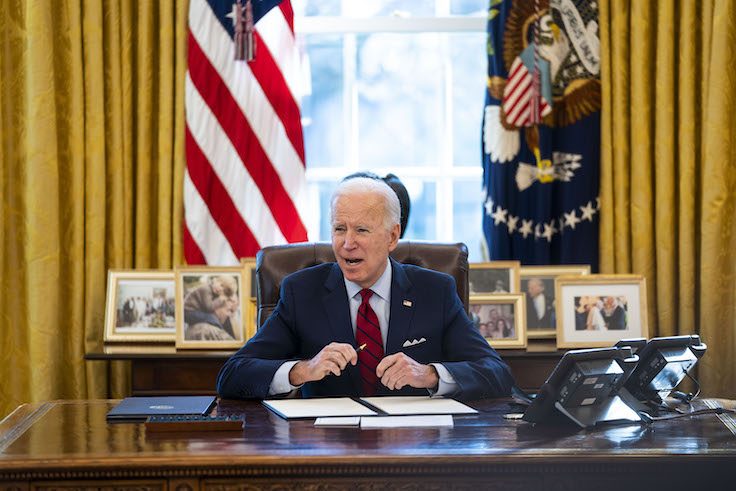
No one can accuse President Biden of easing into office. His first days have been a blizzard of executive orders, presidential memorandums, and official proclamations. He says he wants to overturn the worst policies of the previous administration, and to restore a sense of national unity and institutional integrity. What gets lost in the details of all these initiatives is Biden’s partisan goal.
It’s not just that the new president wants to resume the trajectory America was on when Barack Obama left office in 2017. He also wants to claw back the gains red states made over blue states during the last four years. He wants to shift federal resources to Democratic constituencies, and to save the blue states from the true cost of their misguided policies. And if red America has to pay a price in lost jobs and tax revenue, well, that’s too bad.
Leave aside, for the purposes of this discussion, the relative merits of Biden’s executive actions. (I disagree with almost all of them.) Focus instead on their distributional effects, not on individuals but on sectors of the economy, on regions of the country, and on the donor bases of the two parties. The image that comes to mind is of swarms of dollars changing course midflight: a mass migration of subsidies, spending, and incentives from the GOP coalition to the Democratic one.
Start with energy. Biden killed the Keystone XL pipeline at a cost of 1,000 jobs and diplomatic goodwill with Canada. He banned fracking on federal lands and paused oil and gas lease sales in the Arctic National Wildlife Reserve. According to a White House fact sheet, he told federal agencies to “accelerate clean energy and transmission projects.” He is sure to bestow federal largesse on the sons of Solyndra.
The alternative energy sector overwhelmingly favors Democrats. Its political investments have paid off. The old-style extractive industries, mainly based in GOP strongholds, will suffer. In some cases they are targeted for extinction. The knock-on effects are serious. “Wyoming state superintendent Jillian Balow notes that her state depends on some $150 million a year in oil and gas federal royalties to fund K-12 schools,” says the Wall Street Journal editorial board.
Other Biden measures resumed the flow of government aid to the special interests behind his campaign. The second Catholic president has jumpstartedfederal funding of Planned Parenthood almost two years after President Trump cut off the nation’s largest abortion provider. Biden also reversed President Trump’s ban on money for “sanctuary cities” that choose not to enforce federal immigration law. That decision will help boost the budgets of progressive municipalities eager to pass off the costs of illegal immigration. Biden’s codification of the Supreme Court’s Bostock decision, which made gender identity protected under civil rights law, and his lifting of the ban on trans soldiers is sure to please a class of donors essential to Democratic Party finances.
Biden’s proposed American Rescue Plan best captures the new administration’s intermingling of public policy and greasy-pole gamesmanship. Take, for example, the $130 billion that Biden wants to spend on K-12 schools. That number is on top of the $67 billion Congress already has committed to reopening elementary and secondary schools.
The additional cash is a handout to the teachers’ unions, who have opposed a return to in-person instruction at every opportunity, and who are among Biden’s closest allies. Biden has adopted the unions’ rhetoric, saying that schools cannot open until they have been renovated. He’s wrong, of course—measures such as masks, hygiene, and social distancing are enough to stop the spread, especially among the elementary schoolers who need in-person classes the most and whose transmission rates are low. But science doesn’t matter. The unions must get paid.
One year after COVID-19 appeared in America, it is more than evident that arbitrary, statewide lockdowns are a disaster for small businesses, which happen to be a key part of the Republican coalition. The states that have done the most to reopen have best weathered the economic storm. And these same states tend to be low-tax, low-minimum-wage, and have a business-friendly regulatory environment, as well as a warmer climate. The Wall Street Journal reports that the South is leading America’s recovery. But, in the heavily Democratic northeast, “The recovery of jobs has lagged behind.”
What does Biden want? His solution is to make Florida and Texas more like New York and California. My colleague at the American Enterprise Institute, Paul H. Kupiec, calculates that the nationwide $15 minimum wage contained in the American Rescue Plan would “shift business formation, growth, and employment from red states to blue, as the higher minimum wage erodes red states’ labor cost advantage in many job categories.” What’s best for Cuomo, however, is not what’s best for the country.
A steep minimum wage hike in the middle of an economic crisis that disproportionately affects small business is the exact opposite of what you want to do to spur full employment. But it does make sense if you are using the crisis to gain leverage for unions and government over free labor and the private sector.
Blue America began to claw back red America’s earnings last week. And the next four years (at least) will see the Biden coalition press its advantage.
Ah, normalcy.